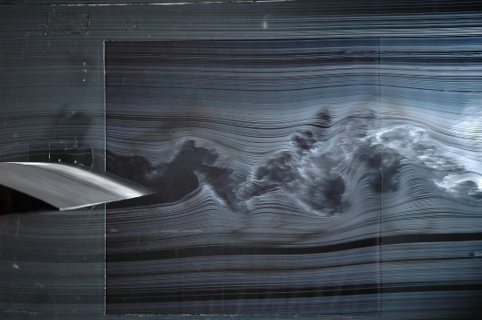Research Areas in Aerodynamics and Fluid Mechanics
Aerodynamic Control
Aerodynamic control of low Reynolds number flow using synthetic jet actuation has significant applications across multiple fields:
- Design and operation of unmanned aerial vehicles (UAVs) at low speeds
- Separation control at jet engine inlets
- Optimized design of compressor blades
Over several decades, researchers have tested various control methods:
| Method | Advantages | Limitations |
|---|---|---|
| Continuous suction | Reduces drag by removing slow-moving boundary layer fluid | Complex plumbing, additional weight |
| Continuous blowing | Adds momentum to stagnant fluid near surfaces | Power requirements offset aerodynamic gains |
| Vortex generators | Simple implementation | Fixed performance envelope |
| Heat strips | No moving parts | Energy intensive |
| External audio excitation | Non-intrusive | Limited effectiveness range |
| Synthetic jet actuation | No net mass flow, efficient | Requires precise timing control |
Our research has employed both acoustic and mechanical control to understand flow mechanisms over a NACA 0024 airfoil. This work has characterized both external (acoustic) and internal (Synthetic Jet Actuator) control methods. We’ve integrated these findings with our wind turbine research to optimize power generation in the 1-5 kW range for low wind speed regions, particularly throughout Ontario.

Aeroacoustics
Aircraft noise reduction is critical for urban airport integration, with airframe noise being a significant contributor—especially during landing operations. Landing gear systems represent the major source of airframe noise. Our research aims to accurately calculate and predict sound pressure levels (SPL) across frequency ranges.
We’ve also conducted targeted studies addressing specific industry challenges and requirements.

Advanced Turbulence Statistics from Big Data
Particle Image Velocimetry (PIV) data processing presents significant computational challenges:
- Traditional processing is too time-intensive for active control systems
- Dataset size constraints limit analysis scope
- Uncertainty quantification remains an outstanding challenge
Our approach leverages GPU acceleration to dramatically improve processing capabilities. We’ve achieved acceleration factors up to 120x for certain algorithms, enabling real-time or near-real-time analysis. This represents a transformative capability for experimental fluid mechanics.
In addition to GPU-based advancements, recent work by Shirinzad et al. (2023) has improved CPU-based PIV processing through an enhanced Python-based open-source software, offering greater flexibility and stability for large datasets.
Processing Time Comparison
| Image Size | ASUS CPU | Jetson TX1 | Speed Improvement |
|---|---|---|---|
| 128 × 256 | 0.461 s | 0.018 s | 25.6× |
| 368 × 512 | 2.386 s | 0.024 s | 99.4× |
| 1024 × 1280 | 16.023 s | 0.071 s | 225.7× |
| 2160 × 2560 | 68.607 s | 0.274 s | 250.4× |
Selected Publications
2025
- Jaber et al.
Jaber, K., Essel, E. E., & Sullivan, P. E. (2025). GPU-Native Adaptive Mesh Refinement with Application to Lattice Boltzmann Simulations.
Computer Physics Communications, 109543.
https://doi.org/10.1016/j.cpc.2025.109543 [JIF: 7.200]
2024
- Ho et al.
Ho, H.H., Shirinzad, A., Essel, E.E., and Sullivan, P.E. (2024). Synthetic Jet Actuators for Active Flow Control: A Review.
Fluids, 9, 290.
https://doi.org/10.3390/fluids9120290 [JIF: 3.094] - Ho et al.
Ho, H., Essel, E. E., and Sullivan, P. E. (2024). Improving Three-Dimensional Synthetic Jet Modeling in a Crossflow.
ASME. J. Fluids Eng., 146(3), 031302.
doi.org/10.1115/1.4064185 [JIF: 2.412] - Machado et al.
Machado, A., Xu, K., & Sullivan, P. E. (2024). Spanwise control authority of synthetic jets on a stalled airfoil.
Physics of Fluids, 36(6), 064113.
https://doi.org/10.1063/5.0212135 [JIF: 4.532] - Machado et al.
Machado, A., Xu, K., & Sullivan, P. E. (2024). Visualizing three-dimensional effects of synthetic jet flow control.
Journal of Visualization.
https://doi.org/10.1007/s12650-024-00992-0 [JIF: 2.024] - Shi et al.
Shi, X & Sullivan, P. E. (2024). Plasma Actuator Separation Control Investigated with Spectral Proper Orthogonal Decomposition.
AIAA Journal, 62(5), 1755–1774.
https://doi.org/10.2514/1.J063327 [JIF: 2.991] - B. Xu et al.
Bin Xu, Liu, T., Shi, X., Sullivan, P. E., Chen, Z., & Chen, X. (2024). Mitigation of crosswind effects on high-speed trains using vortex generators.
Physics of Fluids, 36(7), 075199.
https://doi.org/10.1063/5.0218270 [JIF: 4.532]
2023
- Arafa et al.
Arafa, N, Sullivan, P.E. and Ekmekci, A. (2023). Noise and Jet Momentum of Synthetic Jet Actuators with Different Orifice Configurations.
AIAA Journal.
https://doi.org/10.2514/1.J062920 [JIF: 2.991] - Jiang et al.
Jiang, S., Yu, J., Yin, S., Yang, Y., Chen, F., and Sullivan, P. E. (2023). Uncertainty Quantification of Separation Control with Synthetic Jet Actuator over a NACA0025 Airfoil.
Aerospace Science and Technology, Vol. 133, 108106.
https://doi.org/10.1016/J.AST.2023.108106 [JIF: 5.343] - Shirinzad et al.
Shirinzad, A., Jaber, K., Xu, K., Sullivan, P.E. (2023). An Enhanced Python-Based Open-Source Particle Image Velocimetry Software for Use with Central Processing Units.
Fluids, 8, 285.
https://doi.org/10.3390/fluids8110285 [JIF: 3.094] - K. Xu et al.
Xu, K., Lavoie, P., & Sullivan, P. (2023). Flow Reattachment on a NACA 0025 Airfoil Using an Array of Microblowers.
AIAA Journal, 61(6), 2476–2485.
https://doi.org/10.2514/1.J062512 [JIF: 2.991]
2022
- Arafa et al.
Arafa, N., Sullivan, P. E., & Ekmekci, A. (2022). Jet Velocity and Acoustic Excitation Characteristics of a Synthetic Jet Actuator.
Fluids, 7(12), 387.
DOI: 10.3390/FLUIDS7120387 [JIF: 3.094] - Ho et al.
Ho, H. H., Essel, E. E., & Sullivan, P. E. (2022). The interactions of a circular synthetic jet with a turbulent crossflow.
Physics of Fluids, 34(7), 075108.
https://doi.org/10.1063/5.0099533 [JIF: 4.532]
